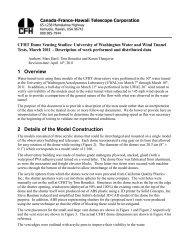ALLEN BRADLEY 1747-L551 PLC Processor
ALLEN BRADLEY 1747-L551 PLC Processor
ALLEN BRADLEY 1747-L551 PLC Processor
Create successful ePaper yourself
Turn your PDF publications into a flip-book with our unique Google optimized e-Paper software.
2–6<br />
Selecting Your Hardware Components<br />
Protocol Options<br />
Ethernet TCP/IP Protocol — Standard Ethernet, utilizing the<br />
TCP/IP protocol, is used as the backbone network in many office and<br />
industrial buildings. Ethernet is a local area network that provides<br />
communication between various devices at 10 Mbps. This network<br />
provides the same capabilities as DH+ or DH-485 networks, plus:<br />
• SNMP support for Ethernet network management<br />
• optional dynamic configuration of IP addresses using a BOOTP<br />
utility<br />
• SLC 5/05 Ethernet data rate up to 40 times faster than SLC 5/04<br />
DH+ messaging<br />
• ability to message entire SLC 5/05 data files<br />
• much greater number of nodes on a single network possible<br />
compared to DH-485 (32) and DH+ (64)<br />
Data Highway Plus (DH+) Protocol — The Data Highway Plus<br />
protocol is used by the <strong>PLC</strong>-5 family of processors and the SLC 5/04<br />
processor. This protocol is similar to DH-485, except that it can<br />
support up to 64 devices (nodes) and runs at faster communication<br />
(baud) rates.<br />
DH-485 Protocol — The SLC 500 processors have a DH-485<br />
channel that supports the DH-485 communication network. This<br />
network is a multi-master, token-passing network protocol capable of<br />
supporting up to 32 devices (nodes). This protocol allows:<br />
• monitoring of data and processor status, along with program<br />
uploading and downloading of any device on the network from<br />
one location<br />
• SLC processors to pass data to each other (peer-to-peer<br />
communication)<br />
• operator interface devices on the network to access data from any<br />
SLC processor on the network<br />
DF1 Full-Duplex Protocol — DF1 Full-Duplex protocol (also<br />
referred to as DF1 point-to-point protocol) allows two devices to<br />
communicate with each other at the same time. This protocol<br />
allows:<br />
• transmission of information across modems (dial-up, leased line,<br />
radio, or direct cable connections)<br />
• communication to occur between Allen-Bradley products and<br />
third-party products<br />
Publication <strong>1747</strong>-6.2




![Documentation [PDF] - Canada France Hawaii Telescope ...](https://img.yumpu.com/26965302/1/190x245/documentation-pdf-canada-france-hawaii-telescope-.jpg?quality=85)







